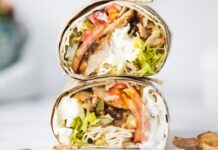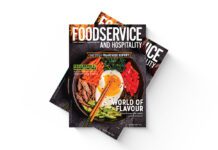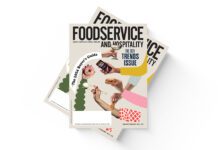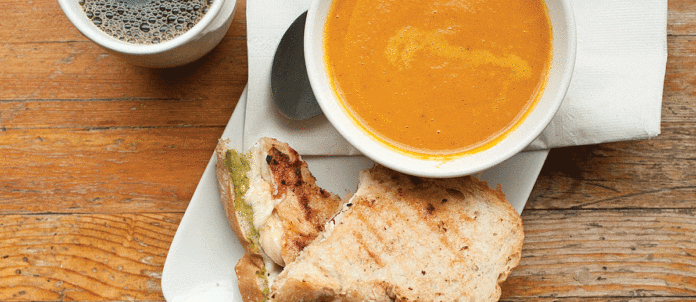Volume 47, Number 9
By: Liz Campbell
[dropcap size=big]W[/dropcap]hen the Earl of Sandwich invented his namesake, he didn’t want to stop gambling to dine, so he simply placed a slab of meat between two slices of bread. With no condiments or other fillings, that first sandwich bore little resemblance to its modern incarnation, but it had one strong similarity —convenience.
The sandwich still meets that basic need for convenience, but consumers want more. “Customers want speed and [a good] price, but they also want taste, and they want to feel good about what they eat,” says Brady Muller, chef/owner of Ciboulette in Halifax. “Many of our customers are regulars, so they don’t want the same old, same old, every day.”
Making the same old different is why the classic chicken club is the most popular sandwich at Ciboulette; there it comes panini-style with chicken, bacon, tomato, mozzarella, avocado and chipotle mayonnaise ($6.96). And ordinary grilled cheese becomes extraordinary with sun-dried tomatoes, basil and rosemary aioli ($6.96).
“It’s not necessary to re-invent the wheel,” asserts Anthony Rose, chef/owner of Rose & Sons in Toronto. “Good simple classics are the best.” Nonetheless, his PLB Special Melt Breakfast sandwich — bacon, sausage, pickle, fried egg and fried onions topped with cherry jam on buttery caraway rye ($13) — is not your classic sandwich.
“It’s not trendy to have a big menu, but I like the idea of options,” says Matthew Schnarch, chef/owner of Café Pavé in Old Montreal, whose menu offers 22 sandwiches. “I cross-utilize many of the ingredients, so I can customize and create interesting combinations.” Thus, a simple chicken sandwich can take on enormous flavour variations, from the Tokyo with English cucumber, tomato and kamikaze sauce (slightly spicy mayo with candied ginger) to the Tunis with sun-dried tomato, goat cheese, spinach with roasted garlic and creamy pesto ($10.99 each with soup/salad and beverage).
“These days it’s all about customization,” affirms Emma Hyatt, Foodservice specialist at the NPD Group Inc. in Toronto. “Fast-casual is still an emerging segment, but its major source of growth is high quality, customizable, unique ingredients not normally found in fast food.”
Tim Hortons has taken its menu to the next level by introducing steak, an item not normally associated with QSR. “We have seen a trend to more higher-end ingredients and bolder flavours,” says Michelle Robichaud, manager, Public Relations at the Oakville, Ont.-based chain. “Our guests are really responding to our new Chipotle Steak and Cheese Panini, made with 100-per-cent Canadian beef ($5.29).”
NPD’s Hyatt calls it premiumization. “Fast-food restaurants are coming out with better quality, tastier, more inspiring ingredients,” she says. “Consumers are resisting spending at full-service but spending more in QSR for higher quality, higher-spec items. Some chains constantly launch limited-time offerings bringing in fun new, interesting lines, which may become permanent.”
Wendy’s has been creative with limited-time offerings such as its Pretzel Pub chicken sandwich ($6.19), or its pulled-pork and crunchy slaw in a toasted brioche with barbecue sauce ($4.99). Even McDonald’s is upscaling with the recent introduction of crispy shrimp wrapped with vegetables and zesty sweet chili sauce ($5.49).
While these premium ingredients inevitably come with a higher price point, there is a market for them. “Consumers are willing to pay for menu items that are made with quality ingredients, because they can see the value they are getting for their money,” says Robichaud.
Fresh ingredients are an important part of that value equation. “Our customers like the fact that our chicken is grilled to order,” says Erica Gale, director of Marketing at Richmond Hill, Ont.-based Extreme Pita. “They want to know their food is freshly prepared.” Grilled chicken with tomato, cucumber, mushroom, romaine lettuce, red onion, green pepper and tzatziki sauce ($7.29 to $7.99) is the top seller here, but customers can request customized premium add-ons such as artichokes and roasted peppers.
While wrapped sandwiches made inroads during the carb-conscious diet-craze days, according to the NPD’s Hyatt, wraps and pitas are still driving sandwich growth. And Gale knows why wraps are a hit. “You taste the fillings rather than the bread,” she says. The owners of Ravi Soups, a Toronto chain opening its fourth location in seven years, can attest to this. The restaurant’s sandwiches come wrapped in a tortilla; the favourite is a meaty curried lamb with mango, pineapple, edamame, spinach and cilantro ($9.99).
Sandwiches are often very meat-centric, so it can be a tough category for vegetarians. Most restaurants offer at least one option, usually substituting cheese or eggs to provide protein. For example, Tim Hortons offers a grilled-cheese panini ($4.20) and egg salad ($3.45). Even The Meatery, a Vancouver restaurant advertising “butcher-to-bun” fare, offers a concession to vegetarians — brie, pear and brown-butter sage sauce ($10).
Meat consumption is down, but, according to the NPD Group, CREST, during the year-ending May 2014, more than 81 per cent of sandwiches contained meat. “People are moving back to higher quality protein but eating less,” says Bett Porta, owner of The Meatery, where the free-range meats are local. The restaurant’s top-selling sandwiches are hoisin-braised beef short rib with pickled cabbage and guacamole; or pulled pork with chipotle slaw ($10 each).
But, while sandwich sales have increased two per cent, according to the NPD Group, CREST, soup has seen a decline of three per cent annually for the last five years. In the past year, soup was only ordered at about four per cent of foodservice visits. “While some operators have had great success with interesting new flavours, it has not been enough to drive overall growth,” says Hyatt.
Nonetheless, soup-centred concepts, such as Ravi Soups, are thriving with game-changing flavours such as curried apricot and red lentil with cilantro, lime crème fraîche and crispy shallots; or corn chowder with blue crab, Thai basil and crispy shallots (both $8.99). “Our regulars come back because the food is healthy. Everything is made from scratch with fresh vegetables and less oil,” says Kamal Kandhasamy, executive chef. “And our food tastes really good, with strong flavours.”
Unique, bolder flavours are popular, and Ciboulette’s Muller isn’t afraid to experiment. “We’ve even tried kimchi soup,” she says. Nonetheless, her consistent top seller is Intense Carrot and Ginger ($6.40 with a biscuit), a soup she describes as “zesty but approachable.”
Jim Phillips, owner of Piping Kettle Soup Co., with two locations in London, Ont., hates to admit his top seller is broccoli and cheddar. “I resisted it for a long time; it’s so boring,” he laments. “But our customers see Piping Kettle as their company; of the more than 100 soups we’ve offered, most were suggested by them. I finally gave in on broccoli cheddar; now it’s always one of the 10 daily soups.”
But regular soups at Piping Kettle also include Indian spiced channa masala soup, coconut lentil (a jalapeño-laced vegan offering) and turkey chili ($2.50 to $6). Although the Piping Kettle offers sandwiches, including the ubiquitous pulled pork, soup comprises 80 per cent of sales. Phillips explains: “People who eat soup, love soup. They’re getting everything in a bowl without a lot of bread; it isn’t as heavy as a sub.”
Soup has also proven to be a valuable upsell in full-service restaurants where it’s included in nine per cent of visits, according to the NPD Group, CREST. But QSR and fast-casual operators are also benefiting from pairing soup with sandwiches. Piping Kettle offers a small soup and small sandwich for $5. At Montreal’s Café Pavé, where the sandwich comes with soup, salad or chips, 50 per cent of guests choose soup; in winter, three-quarters choose hearty soups such as vegetable barley.
Two flavours remain popular among Canadians: tomato and chicken noodle. Tim Hortons’ top seller is premium chicken noodle soup made with white chicken meat ($3.30). Rose & Sons’ Rose serves his chicken soup with a matzo ball ($9), and, he laughs, “I try to make my tomato soup as close to Campbell’s as possible.” Extreme Pita serves Campbell’s soups, but, says Gale, the chain is looking at a new soup strategy for 2015.
In the never-ending struggle to attract customers, originality is key. Take the EXP Restaurant + Bar in Vancouver as an example. The video game-themed restaurant offers zesty sandwiches such as the Epic Shrimp and Crab Sandwich, described as “crispy prawns, crab mix, tempura green onion, avocado, shredded lettuce and wasabi mayo locked in an eternal struggle for superiority!” ($13). It’s a new approach to the epic struggle for the appetites of Canadians who are searching for convenience, unique ingredients and great value.


















